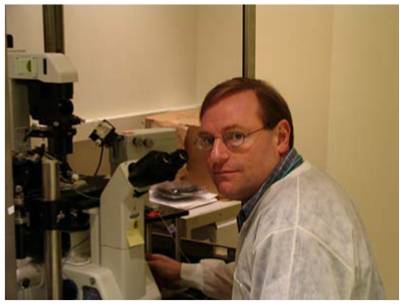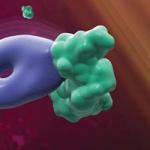
David Lovinger, Ph.D.
Senior Investigator
Laboratory for Integrative Neuroscience
NIAAA
Scientific Director
NIAAA
Research Topics
Research in the Laboratory for Integrative Neuroscience (LIN) examines the role of particular molecules in acute alcohol intoxication, alcohol seeking behavior, addiction and habitual behavior. Another aim of research in LIN is to analyze the structural basis of the pharmacology of membrane proteins that are targets for alcohol actions. An important unifying theme of research within LIN is investigation of forebrain mechanisms involved in aspects of cognition and behavioral control that contribute to addiction. We seek to understand the neural basis of addiction-related brain functions such as decision-making, goal-directed behavior, habit formation and habitual behavior. We are also examining mechanisms underlying specific responses to addictive drugs, including acute intoxication and neural adaptations to chronic drug exposure, such as tolerance and dependence. Gaining an understanding of these functions will necessarily involve determining which neural circuits mediate these processes, what physiological and synaptic mechanisms underlie circuit function and plasticity, and what neural and synaptic molecules play key parts in synaptic, neuronal and circuit function. We believe that these goals can best be achieved by bringing together investigators with a shared interest in these subjects and with diverse technological expertise so that we can approach the problem at multiple levels of analysis.
These aims are being pursued via the coordinated effort of investigators in two independent, interactive sections. Members of these sections have expertise in analyses ranging from molecular biology to physiological and behavioral analysis at the whole animal level. The Section on Synaptic Pharmacology (SSP) is headed by Dr. Lovinger. Members of the SSP have expertise in several areas of molecular and cellular neuroscience. These include molecular techniques for working with cDNA as well as analysis of protein expression, protein phosphorylation and protein-protein interactions. Advanced cell culture techniques are also in use by section members. Members of this section also have considerable expertise in electrophysiological techniques for analysis of single neurons and small neural circuits in brain slices. Expertise in cellular imaging also contributes to the present work and future aims of the SSP.
Research in SSP has focused on two main areas. We have continued our long-standing efforts to understand the cellular and molecular mechanisms underlying plasticity at GABAergic and glutamatergic synapses in the striatum. This work led to an interest in the role of endogenous cannabinoids (endocannabinoids) in synaptic modulation and plasticity in this brain region. Our interest in striatal synaptic plasticity has always been driven by a desire to better understand information storage in this brain region that plays crucial roles in action-outcome, habit and skill learning. Newly developed striatal-specific gene-targeted mouse models are now making it possible for us to determine if striatal synaptic plasticity plays important roles in learning and memory. Our long-term goal in this project is to understand how the molecules and cells of the striatum contribute to the types of learning and memory involving that brain region, and to develop pharmacological and genetic manipulations that can alter striatal-based information storage.
The second long-term area of emphasis in SSP is acute alcohol actions that contribute to intoxication. We continue to explore mechanisms of ethanol (EtOH) action on ligand-gated ion channels using a combination of molecular biological, electrophysiological and kinetic approaches. We have also initiated studies aimed at characterizing pre synaptic actions of EtOH that contribute to potentiation of GABAergic transmission. Our studies have established the presynaptic terminal as the likely site of this EtOH action. Recent studies spurred by ongoing work in the Section on Behavioral Science and Genetics have focused on comparison of electrophysiological and behavioral effects of EtOH in gene-targeted mice lacking molecules that are targets for acute alcohol actions. These studies are designed to examine the effects of acute ethanol as well as neuroadaptations brought about the chronic alcohol exposure. Our role in this part of the research effort is to examine EtOH sensitivity of receptors and alcohol effects on synaptic transmission using in vitro preparations.
The Section on Neuronal Structure (SNS), headed by Dr. Veronica Alvarez is examining dynamic change in neuronal morphology in relation to synaptic transmission, neurophysiology and behavior. In this section, advance microscopy methods, including multiphoton laser microscopy, are used to examine the fine structure of different parts of identified neurons. These microscopy techniques are also used to produce rapid and highly localized increases in neurotransmitter level using laser uncaging, and to examine intracellular signaling produced by these neurotransmitters. Research in this section also involves innovative techniques for gene expression and fluorescent labeling in individual cells. The recent development of techniques for real-time perturbation of intracellular cytoskeletal structure provides a powerful new tool for this type of research. Behavioral models of learning and drug exposure, ongoing within this section and in collaboration with other UIN sections, will be used to examine how changes in neuronal morphology and physiology contribute to neuronal plasticity and neuroadaptions during addiction.
The Section on In Vivo Neural Function (SIVNF), headed by Dr. David Lovinger (formerly by Dr. Rui Costa), focuses on neural mechanisms of skill learning, goal-directed behavior, habit formation and addiction. One of the major areas of emphasis within this section is on the role of cortical-basal ganglia circuitry in these neural functions. Assessment of the role of particular molecules within these brain regions is also an area of emphasis. To this end, Dr. Costa has developed advanced methodology for in vivo electrophysiological recording in awake mice during different phases of task learning, and he is developing in vivo optical techniques as well. He is now applying these techniques to analysis of transgenic and gene-targeted mice. Members of this section are designing and using sophisticated behavioral paradigms to assess goal-directed and habit learning in mice. In addition, Dr. Costa has outstanding expertise in molecular biological techniques, that has allowed him to create unique and powerful molecular tools and gene-targeted mice that can be used by his own section, and by other LIN investigators.
We envision that the shared interests of LIN investigators and the interactive nature of the laboratory will allow investigators from different groups to combine their expertise in the analysis of neural function at multiple levels. For example, changes in addiction-related behavior in a particular mouse model can be examined in conjunction with analysis of neuronal morphology, signaling in subcellular compartments, and neural circuit function at the micro and macro levels. Examination of molecular expression, location and function can also be applied in the same animals. Ultimately, this should allow us to gain a thorough understanding of the way in which particular neuronal molecules contribute to cellular and circuit functions that ultimately influence behavior. We also envision that interactions and collaborations with other NIAAA laboratories will enhance our ability to analyze these neural functions from the molecule to the whole mouse.
One theme that brings together the different lines of research within LIN is an interest in mechanisms of addiction and habitual behavior. We predict that gaining a better understanding of synaptic plasticity in the striatum and related brain regions will help us to better appreciate how information relevant to habit formation becomes encoded. Our overarching hypothesis is that effects of addictive substances on synaptic structure and transmission will interface with natural plasticity mechanisms to focus habits on drugs of abuse as well as associated stimuli and responses. Thus, understanding the neural basis of habit formation and the molecular actions of intoxicating/addictive substances will allow us to gain a more thorough understanding of addiction. Ultimately, it is hoped that these lines of research can contribute to development of better therapies for neurological disorders and alcoholism.
Biography
Dr. Lovinger received a B.A. in Psychology from the University of Arizona in 1981 and a Ph.D. in Psychology from Northwestern University in 1987. At Northwestern, he worked with Dr. Aryeh Routtenberg studying the roles of Protein Kinase C and its substrate, the GAP-43/F1 protein, in hippocampal long-term potentiation. His postdoctoral research at the NIAAA focused on the effects of alcohol on ligand-gated ion channels. In 1991 Dr. Lovinger moved to the Vanderbilt University School of Medicine as an Assistant Professor, where in 1998 he rose to the rank of Professor. At Vanderbilt he was also the Deputy Director for Biomedical Science and the Director of the Neuroscience Core within the Kennedy Center. Dr. Lovinger joined the NIAAA in 2001 as a Senior Investigator and Chief of the Laboratory of Integrative Neuroscience. His laboratory is currently studying the modulation and plasticity of synaptic transmission at corticostriatal synapses and the mechanisms by which abused substances effect synaptic transmission.
Selected Publications
- Kupferschmidt DA, Juczewski K, Cui G, Johnson KA, Lovinger DM. Parallel, but Dissociable, Processing in Discrete Corticostriatal Inputs Encodes Skill Learning. Neuron. 2017;96(2):476-489.e5.
- Gremel CM, Chancey JH, Atwood BK, Luo G, Neve R, Ramakrishnan C, Deisseroth K, Lovinger DM, Costa RM. Endocannabinoid Modulation of Orbitostriatal Circuits Gates Habit Formation. Neuron. 2016;90(6):1312-1324.
- Mateo Y, Johnson KA, Covey DP, Atwood BK, Wang HL, Zhang S, Gildish I, Cachope R, Bellocchio L, Guzmán M, Morales M, Cheer JF, Lovinger DM. Endocannabinoid Actions on Cortical Terminals Orchestrate Local Modulation of Dopamine Release in the Nucleus Accumbens. Neuron. 2017;96(5):1112-1126.e5.
- Cuzon Carlson VC, Gremel CM, Lovinger DM. Gestational alcohol exposure disrupts cognitive function and striatal circuits in adult offspring. Nat Commun. 2020;11(1):2555.
- Augustin SM, Loewinger GC, O'Neal TJ, Kravitz AV, Lovinger DM. Dopamine D2 receptor signaling on iMSNs is required for initiation and vigor of learned actions. Neuropsychopharmacology. 2020.
Related Scientific Focus Areas



Biomedical Engineering and Biophysics
View additional Principal Investigators in Biomedical Engineering and Biophysics

Molecular Biology and Biochemistry
View additional Principal Investigators in Molecular Biology and Biochemistry

Social and Behavioral Sciences
View additional Principal Investigators in Social and Behavioral Sciences
This page was last updated on Wednesday, June 7, 2023